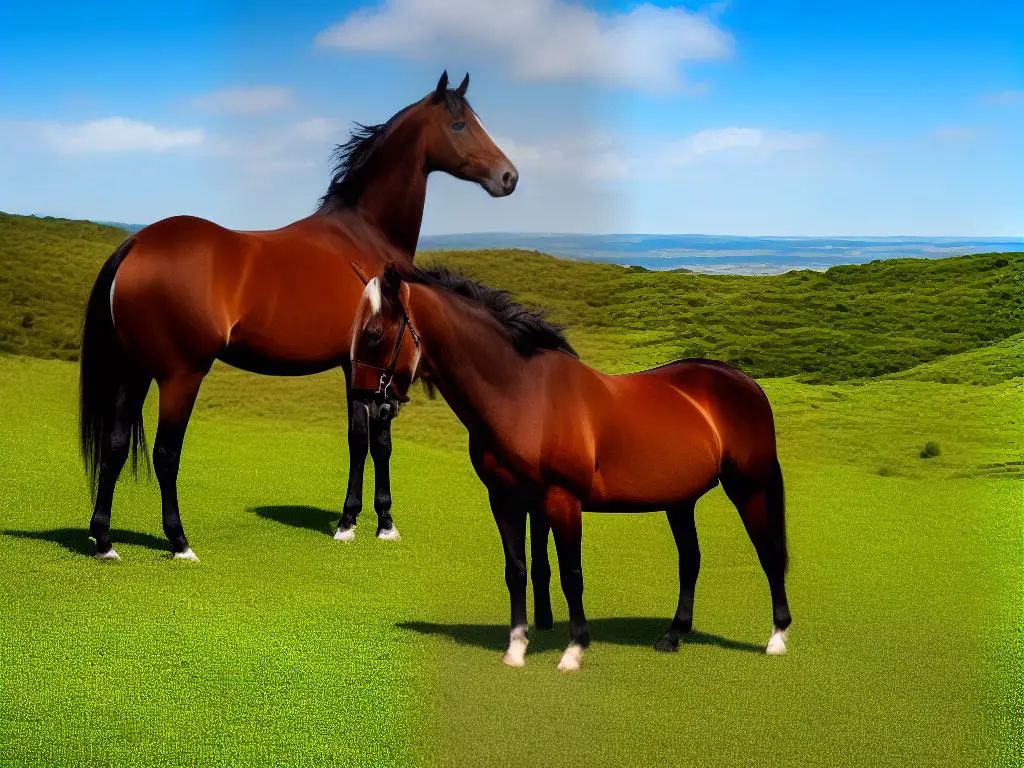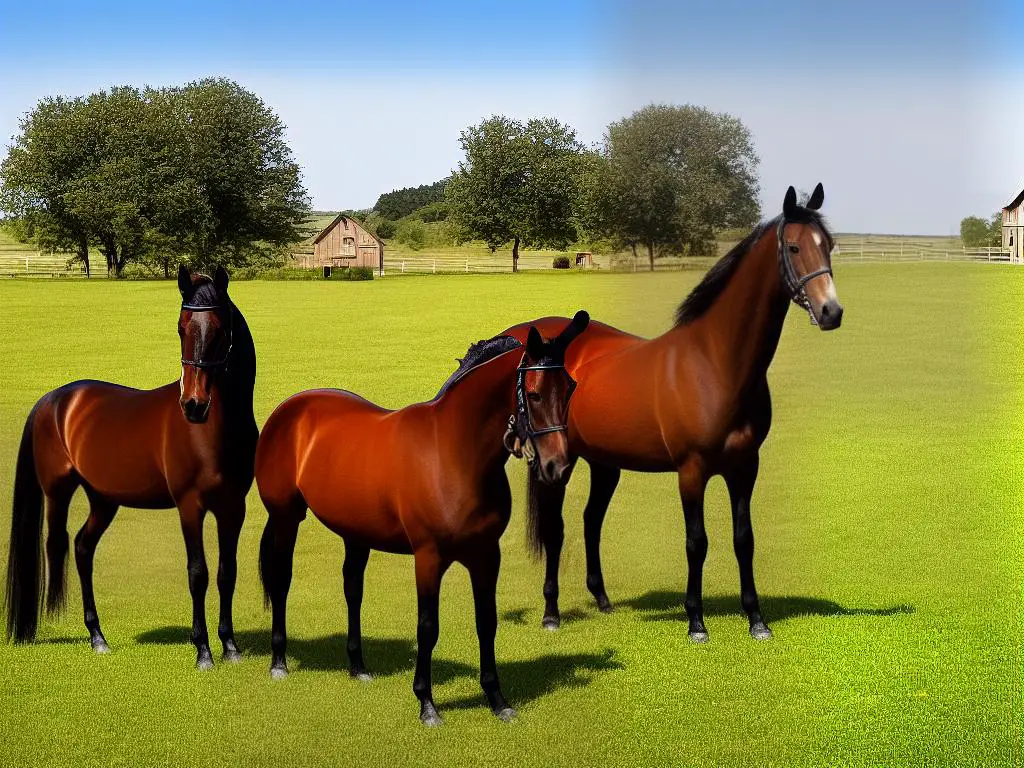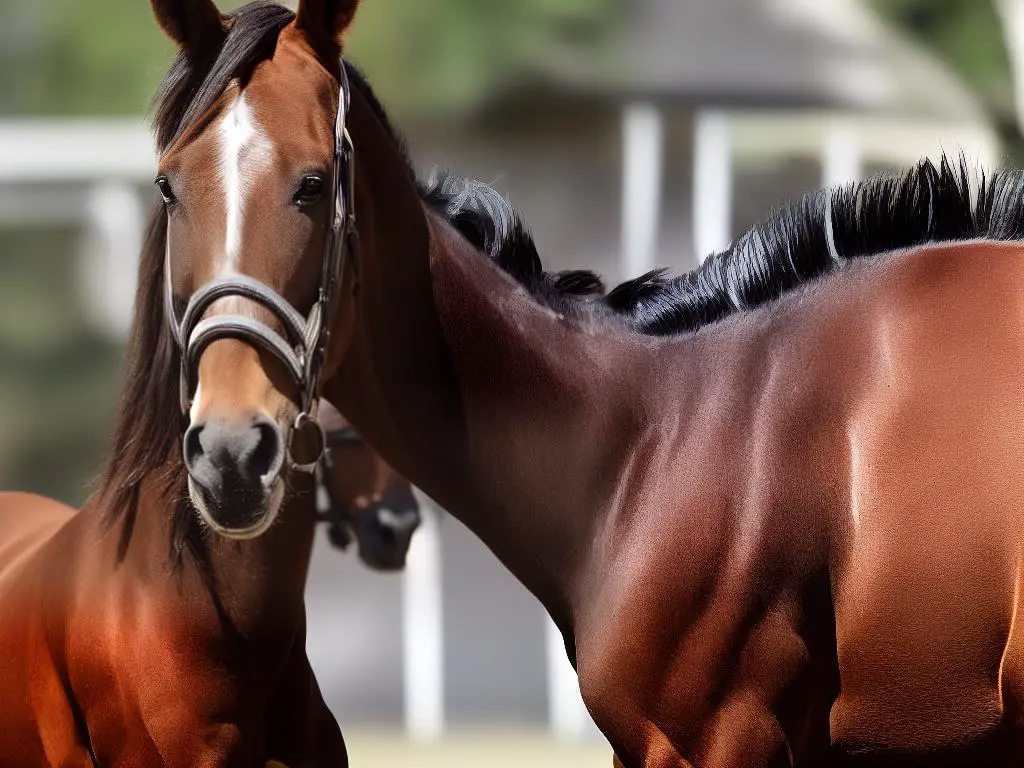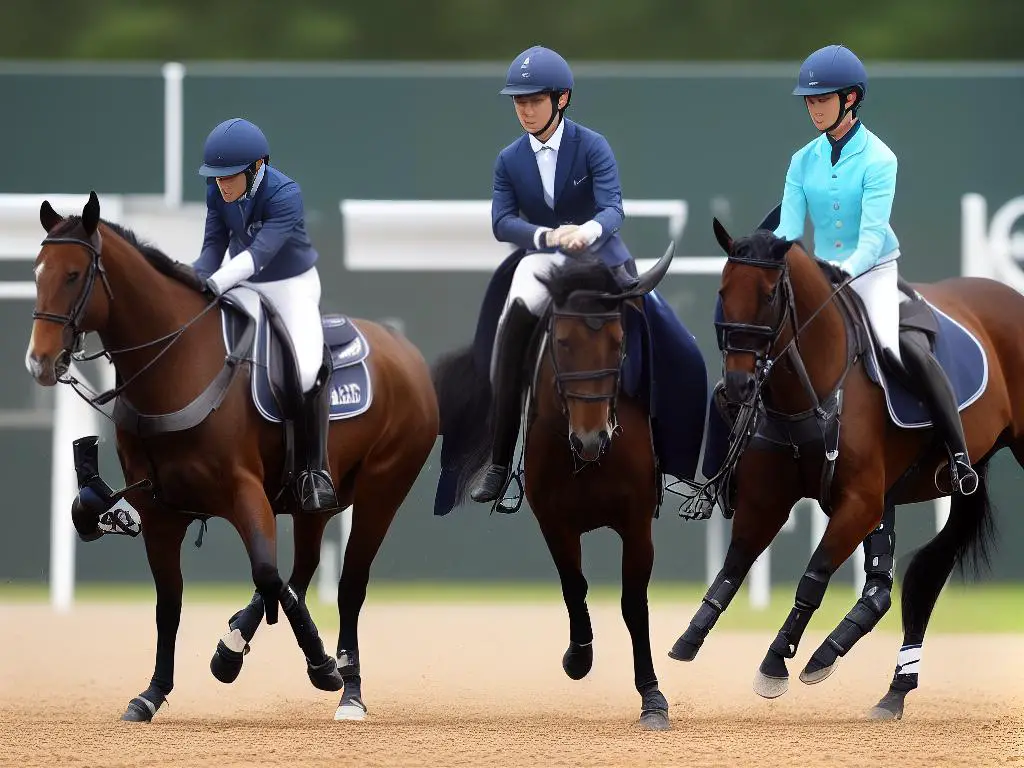The American Saddlebred is a captivating and versatile breed, cherished for its striking appearance, graceful gaits, and exceptional athleticism. With a rich history that can be traced back to the early foundation sires of Denmark and Harrison Chief, the Saddlebred has evolved and flourished as a premier show and utility horse. This essay delves into the intricate aspects of Saddlebred conformation and breeding, providing a comprehensive understanding of this remarkable breed’s qualities that enable it to excel in various disciplines.
Table of Contents (Horspedia)
Saddlebred Breed History & Background
The American Saddlebred has a rich and storied history dating back to the early days of America. Initially, settlers in the New World imported a variety of horse breeds, creating a diverse gene pool for the horses that would ultimately become the American Saddlebred. These foundation breeds included the Thoroughbred, the Narragansett Pacer, and the Morgan Horse, among others. Over time, breeders began to select their foals for specific traits ideal for a general-purpose utility horse with a bold and stylish way of moving, giving birth to the distinctively American breed we know today.Two foundation sires, in particular, were indispensable to the development of the Saddlebred: Denmark, foaled in 1839, and Harrison Chief, born in 1840. Denmark, a Thoroughbred stallion, was known for his incredible trot, high head carriage, and wonderful personality. His offspring inherited his spirited temperament and uniquely stunning movement, contributing significantly to the conformation and motion desired in the breed today. Harrison Chief, another pivotal foundation sire, was admired for his ability to naturally perform the unique five-gaited movements that have since become synonymous with the American Saddlebred – the walk, trot, canter, slow gait, and rack.As the breed evolved, the American Saddlebred grew in popularity and soon became the horse of choice for the wealthy and influential, a symbol of prestige and power. Their flashy gaits, high head carriage, and beautiful appearance made them ideal showring performers, while their versatility and athleticism made them reliable and practical for various disciplines, including driving and as plantation horses. In the late 19th and early 20th centuries, the Saddlebred’s popularity continued to soar, and the horse became the epitome of refinement and elegance in the show ring.The American Saddlebred Horse Association was founded in 1891, securing the breed’s place in American equine history and helping to establish breed standards for conformation and breeding. The saddle seat discipline, in which the Saddlebred excelled, was also gaining momentum during this period, further highlighting the breed’s unique characteristics and gaits. These developments solidified the breed as the foremost horse for saddle seat competition, and it remains a premier competitor in this discipline today.Today, breeders continue to emphasize the importance of conformation in the American Saddlebred – seeking a balanced, proportional horse with a strong, erect neck, a well-defined and smooth topline, and powerful, well-developed hindquarters vital for performing their signature gaits. Conformation plays a critical role in assessing the breeding potential of Saddlebreds, as well as contributing to their overall performance abilities in various disciplines. Known as the “Horse America Made,” the American Saddlebred remains a versatile and popular breed, captivating the hearts of enthusiasts and hobbyists alike by preserving its exceptional conformation and unique traits.

Saddlebred Conformation Essentials
One key aspect of Saddlebred conformation that connects with the breed’s unique features and overall appearance is head shape. An ideal Saddlebred head is refined and well-proportioned to the overall size of the horse, with a straight or slightly dished profile, expressive eyes, and chiseled features. Ears should be set close together and high on the head, giving the horse a lively and intelligent expression. A horse’s head shape not only impacts its aesthetics but also plays a vital role in its breathing, vision, and dental health. These factors can significantly influence the horse’s performance, further demonstrating the importance of proper conformation in the American Saddlebred breed.
Another important aspect of Saddlebred conformation is the length and shape of the neck. This breed is known for long, arched necks that give them a regal appearance and allow them to perform their signature high-stepping gaits with grace and ease. A proper Saddlebred neck should be set high on the withers, be slim yet muscular, and have a natural, graceful curve. The length and carriage of the neck influence the horse’s balance, collection, and ability to extend their movements.
The shoulder angle is another integral component of Saddlebred conformation. A well-sloped shoulder allows for extended and fluid movement of the front legs, allowing Saddlebreds to exhibit their characteristic lofty and graceful gaits. An ideal shoulder angle falls between 45 and 50 degrees relative to the ground. The shoulder angle directly impacts the horse’s reach, freedom of movement, and jumping ability, all essential aspects of a versatile and athletic breed like the Saddlebred.
Back strength and length are essential factors in conformation, as they affect the horse’s overall performance, balance, and ability to carry a rider. A strong back helps to distribute the rider’s weight more evenly and offers comfort and support to both horse and rider. An ideal Saddlebred back is level and not overly long, with well-sprung ribs and a pronounced wither to provide an improved saddle fit. A strong and level back promotes even weight distribution, resulting in more fluid gaits and better overall balance.
Overall balance in a horse’s conformation refers to the proportion and harmony of its physical attributes, ensuring all elements contribute to a visually appealing and well-balanced animal. For American Saddlebred horses, this balance is achieved through careful breeding focused on specific conformation points such as the head, neck, shoulder angle, and back strength. Years of meticulous attention to these critical aspects have resulted in a versatile, athletic, and undeniably elegant horse, with an even distribution of weight from head to tail and from side to side, allowing for greater ease in movement and smooth gaits.

Gaits & Performance
When evaluating American Saddlebred conformation and breeding, it is crucial to recognize the importance of their natural gaits in their performance success. Saddlebreds are known for their animated, high-stepping movements, which set them apart from other horse breeds. Their outstanding ability to perform various gaits—the walk, trot, and canter, along with the unique slow gait and rack—is a testament to the breed’s refined conformation and exceptional breeding practices. A thorough understanding of these distinct movements and their relationship to the horse’s conformation will help enthusiasts and hobbyists become skilled experts in Saddlebred breeding and conformation.
The walk, trot, and canter are the basic gaits for most horse breeds, but Saddlebreds perform them with exceptional flair, grace, and elegance. A Saddlebred’s walk is characterized by an effortless, flowy stride, exhibiting an innate sense of cadence and balance. Simultaneously, their trot is exceptionally animated, resulting from long, powerful limb movements combined with a natural upward reach. While performing the canter, Saddlebreds maintain a relaxed, ground-covering stride that is deceptively fast and smooth, highlighting the breed’s unparalleled athleticism and style.
In addition to these fundamental gaits, Saddlebreds are renowned for their ability to perform the slow gait and rack. The slow gait is a four-beat lateral gait that requires the horse to move its legs in a broken, precise pattern, producing a smooth, gliding movement. The rack, also known as the single-foot, is a flashy, high-stepping four-beat gait executed at considerable speed. Both of these gaits further demonstrate the breed’s incredible versatility and talent and are a result of careful breeding and training efforts.
The impressive natural gaits of Saddlebreds can be directly attributed to their unique conformation and breeding. For a Saddlebred to excel in performance disciplines, it must possess specific physical characteristics that enable the desired movements. These include a well-set, long, and arched neck that allows for an elevated head carriage; a short, strong back that provides stability and balance; powerful hindquarters necessary for energetic impulsion; and long, clean limbs that facilitate smooth, high-stepping action. These traits are strategically bred into Saddlebreds, ensuring the continuation of exceptional performance qualities within the breed.
For enthusiasts and hobbyists seeking to become skilled in Saddlebred conformation and breeding, understanding the essentials of this captivating breed is crucial. Focusing on their natural gaits, such as the walk, trot, and canter, alongside specialized movements exhibited in the slow gait and rack, allows individuals to gain invaluable insight into the importance of proper conformation in achieving success across various performance disciplines. Armed with this knowledge, Saddlebred supporters can continue to appreciate and advocate for the enduring legacy of these iconic American athletes.

Breeding Principles & Practices
Moving on to the breeding aspect of Saddlebreds, considering the desired performance outcomes is one of the most critical factors. Saddlebred horses are renowned for their distinctive high-stepping gait, graceful neck, and overall elegance. Their versatility enables them to excel in a wide range of disciplines, including pleasure, equitation, and driving classes. As such, carefully selecting the ideal mare and stallion combination is imperative to produce offspring with the desired traits and talent suited for a specific discipline.
While selecting compatible mare and stallion, a balanced conformation should be the primary focus. A well-proportioned horse with a functional conformation is more likely to be successful in their chosen discipline and pass on those desirable traits to their offspring. Studying the conformation of both mare and stallion can help predict what the resulting foal might look like, improving the likelihood of achieving the desired attributes for your future Saddlebred. Additionally, it is essential to be aware of any genetic strengths and weaknesses in each horse that could impact the resulting foal’s health and performance.
Pedigree research plays a significant role in Saddlebred conformation and breeding. A well-documented ancestry can indicate the genetic potential of a horse. Many breeders study the lineage to find patterns of success in specific disciplines and physical traits. Understanding a horse’s pedigree can help make informed decisions when choosing a breeding partner and setting expectations for the offspring’s future performance capabilities.
In an effort to produce high-quality offspring, breeders use various generations of crossbreeding, linebreeding, and outcrossing techniques. Crossbreeding involves mating horses from different bloodlines, which can result in improved genetic diversity and potentially healthier offspring. Linebreeding focuses on breeding horses related to a specific ancestor, maintaining and enhancing the desirable characteristics present in multiple generations. On the other hand, outcrossing introduces a new line of genetic material to the existing bloodline, diminishing potential weaknesses and creating valuable new traits.
Achieving success in Saddlebred breeding and conformation necessitates a comprehensive understanding of various factors, including performance outcomes, conformation compatibility, genetic strengths and weaknesses, as well as pedigree research. Having a thorough understanding of these elements is essential for enthusiasts and hobbyists looking to excel in this field and contribute to the continued advancement of this remarkable breed, known for its beauty, versatility, and athleticism.

Genetics & Health Considerations
Key to successful Saddlebred breeding is a solid grasp of the underlying genetics associated with the breed. This knowledge aids in preventing the spread of common genetic conditions and ensures overall health and vitality of the horses. By carefully considering genetic factors along with performance, conformation, and pedigree, you can help shape and enhance the qualities that make the Saddlebred so uniquely desirable for generations to come.
One such condition to be aware of in Saddlebred horses is lordosis, also known as swayback. This condition causes a downward curvature of the horse’s spine, affecting its appearance, comfort, and performance. Although it is often manageable, pairing two affected individuals, or carriers, during breeding can increase the risk of offspring being affected by the condition as well, negatively impacting future generations of Saddlebreds.Another notable genetic condition to be aware of in Saddlebred conformation and breeding is wobbler syndrome. This neurological disorder affects the cervical vertebrae, hindering a horse’s ability to walk properly and causing an unsteady gait. Wobbler syndrome can be attributed to a combination of genetic predisposition and environmental factors, such as poor nutrition and rapid growth. To mitigate the incidence of this disorder, it is important to be aware of the genetic background of the horses used in breeding as well as their living conditions and overall health.Managing health concerns that might arise due to breeding practices is also critical to fostering a Saddlebred’s overall strength and well-being throughout its life. Regular veterinary check-ups, including routine blood work, urinalysis, and fecal examinations, can help identify any health concerns early on and allow for proper treatment in a timely manner. Additionally, proper nutrition and exercise are essential in maintaining the health and vitality of Saddlebred horses, as well as preventing the onset and progression of certain genetic conditions.Paying close attention to the breeding stock’s conformation is equally as important in promoting Saddlebred health. A horse with excellent conformation is more likely to possess the structural strength and balance required for enduring performance and overall health. Furthermore, the presence of genetic defects and health issues can affect a horse’s conformation, as seen in cases of lordosis and wobbler syndrome. To help ensure the overall health and longevity of Saddlebred horses, it is vital to select breeding pairs that exhibit strong, balanced conformation.Lastly, monitoring a Saddlebred’s behavioral, physical, and mental well-being is crucial in maintaining its overall health throughout its life. Breeders and owners must remain vigilant for any signs of stress, discomfort, or behavioral changes in their horses, as these could indicate the presence of various health issues or genetic conditions. By fostering a supportive and attentive environment for Saddlebreds, breeders can enhance the quality and longevity of their horses while reducing the prevalence of conditions that can compromise the breed’s conformation and functionality.

Selecting Quality Breeding Stock
When it comes to selecting quality breeding stock in Saddlebred horses, various attributes contribute to the overall success and athleticism of the horse, and these factors should be carefully considered. Conformation, which refers to the physical build and proportions of the horse, is one such crucial factor. A well-conformed Saddlebred should display a long, elegant neck, a straight back, and strong hindquarters, enabling the horse to excel in its performance disciplines. Ensuring that the horse’s limbs are well-aligned, with no visible deviations or irregularities, is also vital as these can lead to structural weaknesses and potential health issues down the line. By taking all these factors into account, breeders can work towards improving the Saddlebred breed’s conformation and overall health.
In addition to conformation, an essential attribute to consider is the horse’s performance records. Examining a horse’s success in competition can give valuable insight into its athleticism and potential to perform at a high level. A horse with a strong record of successful performances will likely pass on these desirable traits to its offspring, making it a valuable candidate for breeding. It can be beneficial to research the performance records of close relatives, such as siblings, half-siblings, and parents, as these may provide further evidence of the quality and consistency of the horse’s lineage.
Temperament is another critical aspect to take into account when selecting Saddlebred horses for breeding. Saddlebreds are known for their friendly, intelligent, and trainable dispositions, making them popular choices for show and recreational riding. Maintaining these traits in future generations is vital to the Saddlebred’s overall appeal and success in various disciplines. When assessing a horse’s temperament, observe its interactions with other horses and humans, both in and out of the saddle, and consider whether it displays any problematic or aggressive behaviors. Opting for horses that remain calm, responsive, and eager to learn will increase the chances of producing well-mannered, trainable offspring.
A crucial component in choosing top-quality Saddlebreds for breeding is analyzing the pedigree, which provides insight into a horse’s lineage and genetic background. An exceptional pedigree often indicates that the horse comes from a line of successful and athletic Saddlebreds, increasing the likelihood of producing offspring that meet or exceed the breed’s standards. Qualities to look for in a pedigree include multiple generations of successful show horses or breeding stock that consistently produce high-quality offspring. Combining horses with complementary traits and consistent pedigrees can potentially create a more successful and desirable offspring.
One crucial factor in Saddlebred conformation and breeding is the horse’s overall health and reproductive capabilities. Ensuring that both the mare and stallion are in good health and free of any hereditary or genetic issues plays a significant role in the success of the breeding process and the well-being of the offspring. Conduct thorough examinations by veterinarians for any potential health concerns, and complete fertility evaluations for both the mare and stallion. Reviewing the history of successful, healthy foals from previous breedings can also provide valuable information about a horse’s reproductive abilities and potential to produce strong, athletic offspring.

Raising, Training, & Showing Saddlebreds
Raising these Saddlebred foals is an essential part of the breed’s continued legacy and success. From birth, proper socialization and care are required to ensure they grow into confident and well-rounded adults. Allow foals to interact with other horses during their early days and experience essential herd dynamics. As they grow and develop, handle them regularly and introduce them to various situations such as leading, grooming, and picking up hooves. These interactions help the foal become comfortable around humans and learn how to respond to different cues, laying the foundation for their future training and success within the discipline.
When it comes to training Saddlebreds, there are a variety of methods and disciplines that owners and trainers can explore. For example, groundwork exercises that focus on communication, trust, and respect between the horse and handler are fundamental to success. Once the horse has matured and gained strength, riders can begin introducing saddle work and specific techniques tailored to their chosen discipline. Some Saddlebreds will excel in fine harness, while others may be more suited to park, country pleasure, or three and five-gaited classes.
A crucial aspect of Saddlebred training is the development of their natural gaits. Saddlebreds are known for their smooth, high-stepping action, which is showcased in both three and five-gaited competitions. In addition to the walk, trot, and canter, horses in five-gaited classes also perform the slow gait and rack, both highly collected and animated movements. Specialized training methods, such as using weighted shoes or a “tied-in” tail to encourage higher tail carriage, can help enhance these signature gaits.
Entering the show world with a Saddlebred can be an exciting endeavor, as it provides an opportunity to showcase your horse’s training, conformation, and abilities. To be successful in the show ring, it’s important to familiarize yourself with the rules and regulations of each specific class, as well as proper show etiquette. Ensuring your horse is well-groomed and turned out appropriately is also essential to make a good impression on the judges.
Understanding and assessing Saddlebred conformation plays a key role in breeding these horses for success. Breeders must evaluate not only physical characteristics but also temperament, movement, and athletic ability when making mating decisions. By carefully selecting and pairing horses that complement each other’s strengths and address any weaknesses, breeders can produce the next generation of talented and versatile Saddlebreds, who will carry on the tradition of competition and distinguished elegance that defines the breed.

Through a deep understanding of Saddlebred conformation, breeding principles, and performance, enthusiasts and hobbyists can elevate their appreciation and expertise in this exquisite breed. By selecting quality breeding stock, managing genetic and health considerations, and fostering proper training and showing practices, the American Saddlebred will continue to captivate the hearts of horse lovers around the world and maintain its prestigious legacy as a truly versatile and elegant equine athlete.